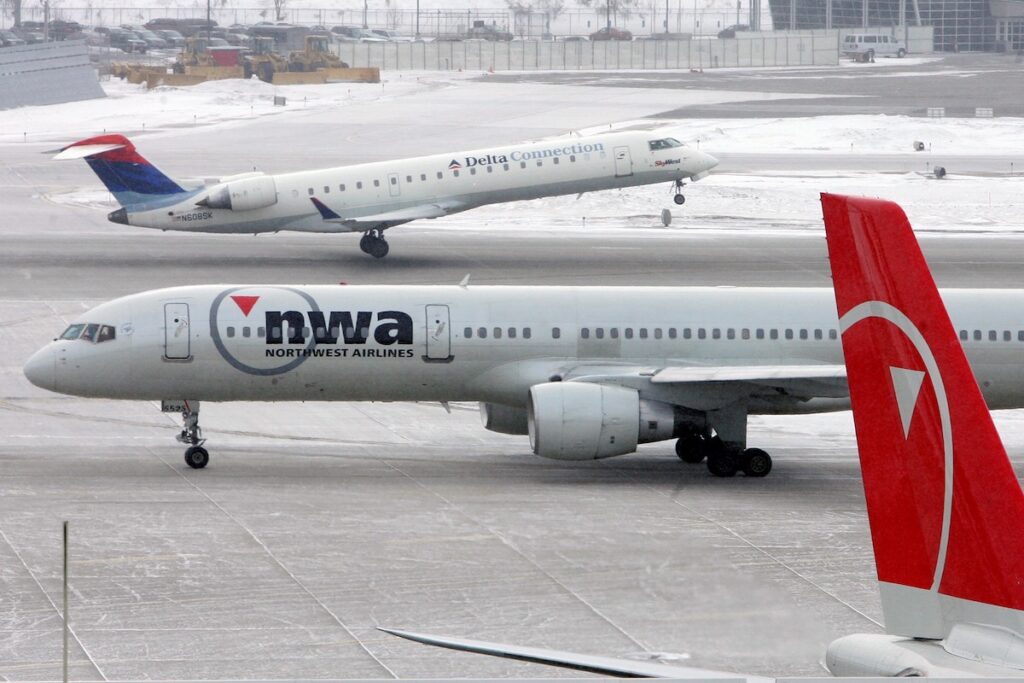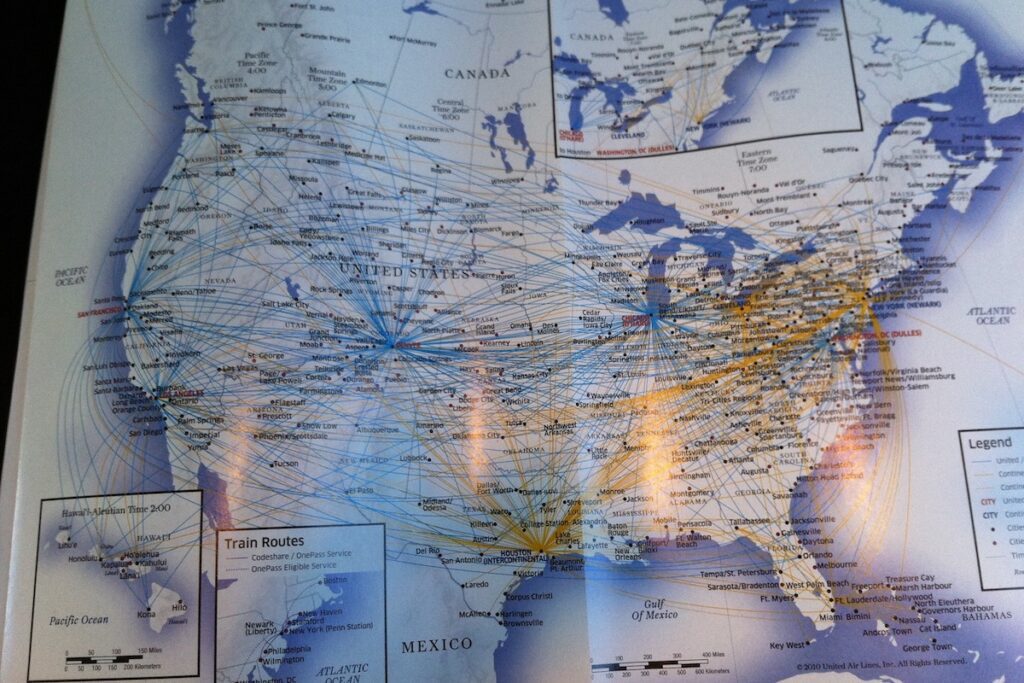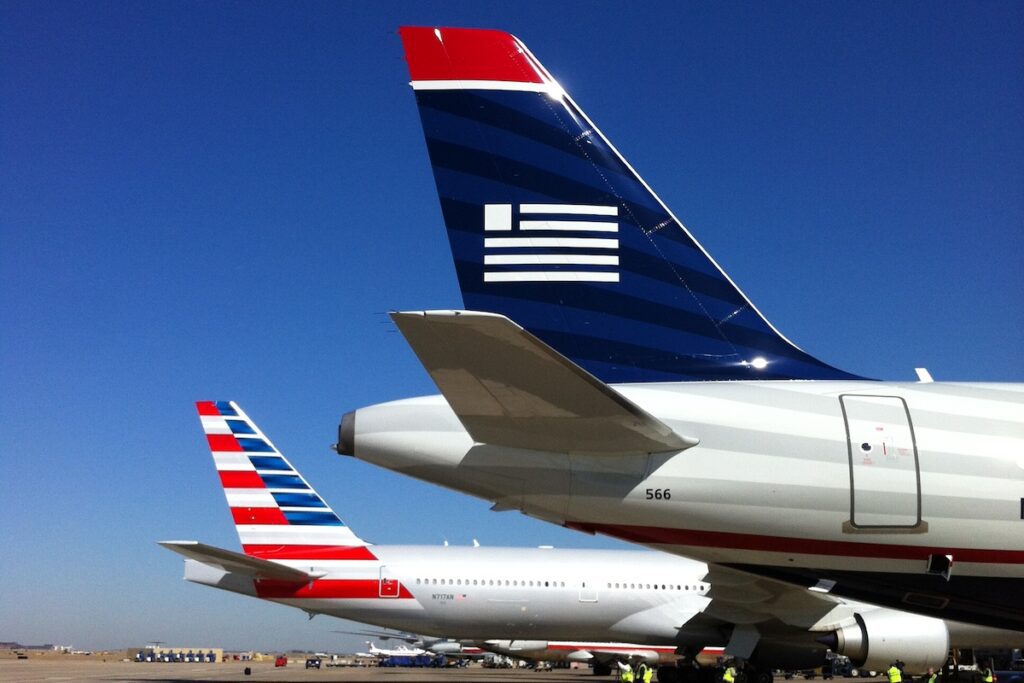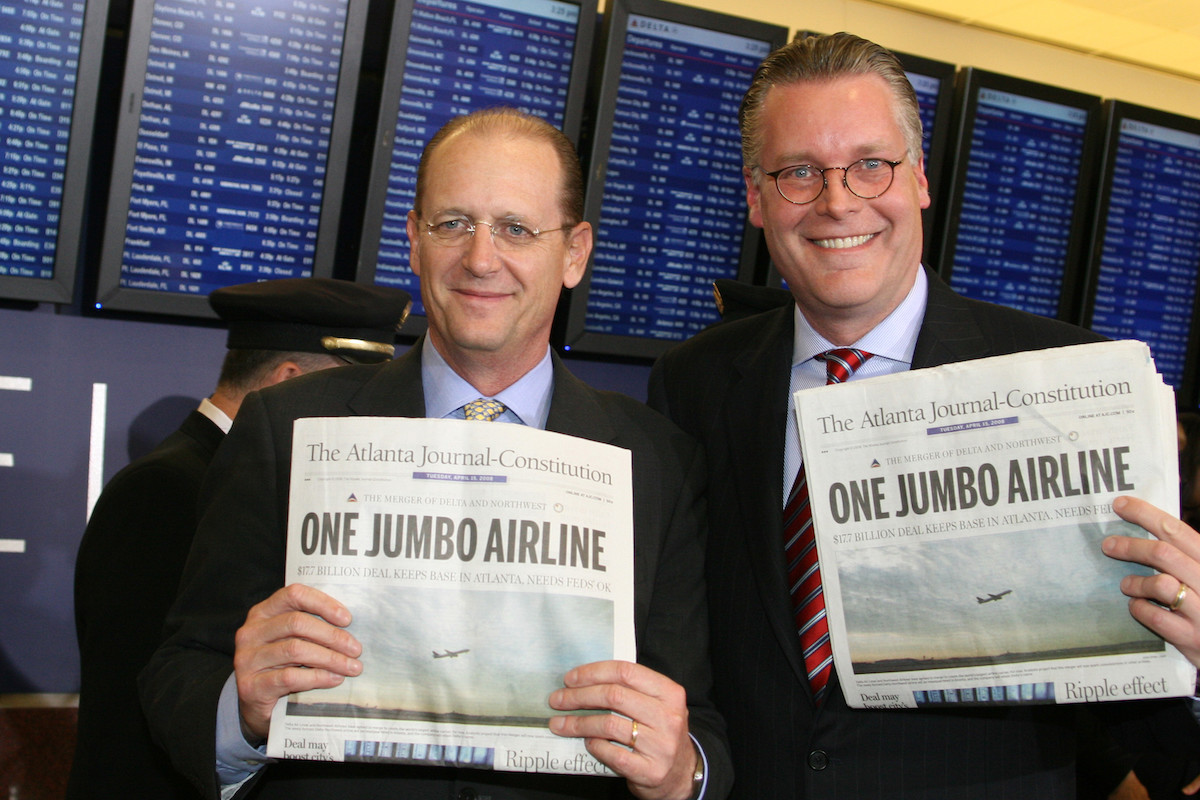Skift Take
Eight mergers have really shaped the U.S. airline industry we have today.
The U.S. airline industry today is dominated by four big airlines: American Airlines, Delta Air Lines, Southwest Airlines, and United Airlines. Together, they fly 78% of all of the seats in the U.S. market.
It was not always this way. At the turn of the 21st century, these same four airlines controlled just over a 50% share of all seats in the U.S. domestic market, according to Bureau of Transportation Statistics (BTS) data via Cirium Diio.
Eight big airline mergers since 2000 have reshaped the U.S. industry. Storied names including Continental Airlines, Northwest Airlines, and US Airways all disappeared into other brands — living on only in memory and the rare heritage livery jet.
Now, two more mergers are proposed. JetBlue Airways wants to buy Spirit Airlines for $3.8 billion in a deal the Justice Department is trying to block. And Alaska Airlines has agreed to buy Hawaiian Airlines for $1.9 billion.
Here’s a timeline of the mergers that have reshaped the U.S. airline industry since 2000.
2001: American and TWA
Just 10 days into the new year, American announced plans to buy long-struggling Trans World Airlines for $500 million in cash plus the St. Louis-based carrier’s aircraft operating leases. At the time, the deal would jump American up two notches to be the second-largest U.S. airline behind only Delta based on total seats, BTS data show. The deal closed in April 2001.
But American’s grand plans to use TWA to make itself a larger, more formidable competitor fell to the wayside after the September 11 attacks. In the days and weeks immediately following the terrorist attack, the airline needed to make deep cuts to survive. American parked all of TWA’s McDonnell Douglas DC-9 jets that October, and quietly folded TWA into itself that December. In 2009, American closed TWA’s former St. Louis hub, which it had once envisioned as a third key Midwestern gateway after Dallas-Fort Worth and Chicago.
2005: America West and US Airways
On May 19, 2005, America West Airlines announced a deal to buy bankrupt US Airways in a transaction valued at $1.5 billion. The combined airline was led by America West management, including CEO Doug Parker who will come up again in the story of U.S. airline mergers. It kept America West’s Arizona headquarters but adopted the US Airways name.
The resulting carrier was the fourth-largest in the U.S. behind Delta, Southwest, and American in terms of seats, according to BTS data.
The America West-US Airways deal really was the first merger of the modern era. It showed industry executives that, by bringing two smaller airlines together and increasing scale, the resulting carrier could turn greater profits. The combination kicked off the talks that would eventually result in the mega mergers that brought us the American, Delta, Southwest, and United of today.
2008: Delta and Northwest
This really was the first airline mega merger. Yes, America West and US Airways was big — but it was nowhere as big as Delta and Northwest. The deal, which was unveiled in April 2008, brought together the third (Delta) and seventh (Northwest) largest airlines by seats in the U.S. into a new market leader with a 20% share of all domestic and international seats in and out of the country, BTS data show.
The next largest airline, Southwest, only had a 15% share of just the domestic market. And the next largest intercontinental carrier, American, just had a 14% share.
The $2.8 billion deal closed that October.

2009: Frontier and Midwest
The Frontier Airlines and Midwest Airlines merger is one nobody really talks about because it failed miserably. Regional airline Republic Airways, with grand ambitions for its own major carrier, bought Midwest in July 2009 and Frontier out of bankruptcy that October.
It combined the airlines under the Frontier name. But the merger never succeeded like Republic hoped, and the carrier began looking for a buyer in 2011. The eventual sale to private equity firm Indigo Partners in 2013, however, led the Frontier we know today — the second largest deep discounter in the U.S. market. Frontier went public in 2021.
2010: United and Continental
Announced on May 3, 2010, the United-Continental combination was the second mega-merger in the U.S. market. The all-stock deal valued at $3 billion would see Continental’s CEO Jeff Smisek lead the combined company headquartered in Chicago under the United brand.
The deal was a powerful combination: Continental’s Houston and Newark hubs added key geographic strengths to United’s gateways, and gave the combined airline a large presence in Asia, Europe, and Latin America. And it would hurdle United up two notches to just behind Delta as the largest U.S. airline by seats, according to BTS data.
The merger closed in October 2010, and Continental was fully integrated into United in 2012.

2011: Southwest and AirTran
While Southwest was long among the largest domestic U.S. airlines, it lacked two big things as pressure mounted from its ever larger competitors: International routes and a significant presence in the southeast.
Enter AirTran with its Atlanta hub and its ability to expand to the Caribbean and Latin America. Southwest agreed to buy the Orlando-based carrier for $1.37 billion, or $3.4 billion including debt, in September 2010. The deal would combine the second (Southwest) and seventh (AirTran) largest U.S. airlines by seats, according to BTS data.
The Justice Department approved the merger in April 2011 and the deal closed that May.
While not as big as either Delta-Northwest or United-Continental, the Southwest-AirTran combination would see the three largest U.S. airlines each have an 18% or more share of seats in the market based on 2010 numbers. That left only American and US Airways out with 13% and 10% shares, respectively.
2013: US Airways and American
If there is something to be said about US Airways and its management team lead by Parker, it’s that they never saw an opportunity too big to pass up. They unsuccessfully attempted to buy Delta with an unsolicited offer in 2006. And, after seeing their competitors get steadily bigger, knew they needed to do the same.
That’s why when American filed for Chapter 11 bankruptcy protection in November 2011, Parker saw an opportunity. What proceeded was a year-long courtship that included wooing American’s labor unions, creditors, and ultimately American management itself to reach the $11 billion deal that was announced on Valentine’s Day in 2013.
Parker would lead the combined airline that would be based in Fort Worth, Texas, and take the American name. The “new” American would be the market leader, vaulting the fourth- and fifth-largest U.S. airlines well ahead of the largest, Delta, with a 23% share of all domestic and international seats, BTS data show.
After initial objections from the Obama Justice Department, the American-US Airways merger received regulatory sign off in November 2013 and the deal closed that December.

2016: Alaska and Virgin America
In April 2016, when Alaska announced it would buy Virgin America for $2.6 billion, or $4 billion including debt and aircraft leases, it proved the foil to JetBlue’s growth ambitions on the West Coast.
It was no secret that JetBlue wanted Virgin America for itself, and that Alaska just offered more money for the California-based carrier. But ask Alaska, and the deal was not to block a competitor, but for greater access to the competitive Los Angeles and San Francisco markets.
The combination brought together the country’s sixth (Alaska) and 11th (Virgin America) largest airlines with combined seats that would make them a solid fifth in the U.S. market, according to Cirium Diio data.
The deal closed after Justice Department approval in December 2016.
Pending Mergers
JetBlue and Spirit: When Frontier and Spirit announced plans to merge in February 2022, JetBlue management jumped into action. They were not about to be left out of U.S. airline consolidation again and unveiled a counter, unsolicited bid in April. What followed was a bidding war between Frontier and JetBlue, and the latter’s ultimate win with a $3.8 billion offer — a $900 million premium over Frontier’s initial offer — that July.
What’s followed has been well documented: Spirit shareholders approved the deal that October; the Justice Department sued to block it in March; and the trial in the DOJ’s suit kicked off in October.
If approved — when the judge will rule is unknown — JetBlue and Spirit would be the fifth-largest U.S. airline by seats with a roughly 8% share based on 2023 numbers, Cirium Diio data show.
Alaska and Hawaiian: In a surprise twist, Alaska unveiled a deal to buy Hawaiian for $1.9 billion including debt on Sunday. The combined airline, which will operate with two customer-facing brands — Alaska and Hawaiian — would be the fifth largest in the U.S. with a 5% share of seats; they would be sixth if the JetBlue-Spirit deal is approved.
Alaska CEO Ben Minicucci said Sunday that the airlines have not discussed the combination with the government, and the risk of a Biden Justice Department objection is very real. Assuming everything goes to plan, Alaska and Hawaiian aim to close the merger by June 2025.
The Daily Newsletter
Our daily coverage of the global travel industry. Written by editors and analysts from across Skift’s brands.
Have a confidential tip for Skift? Get in touch
Tags: airlines, alaska airlines, american airlines, delta air lines, frontier airlines, hawaiian airlines, jetblue, mergers and acquisitions, southwest airlines, spirit airlines, united airlines
Photo credit: Delta CEO Richard Anderson (left) and then-President Ed Bastian (right) after the announcement of the airline's merger with Northwest in 2008. (Delta) Delta Air Lines / Flickr
